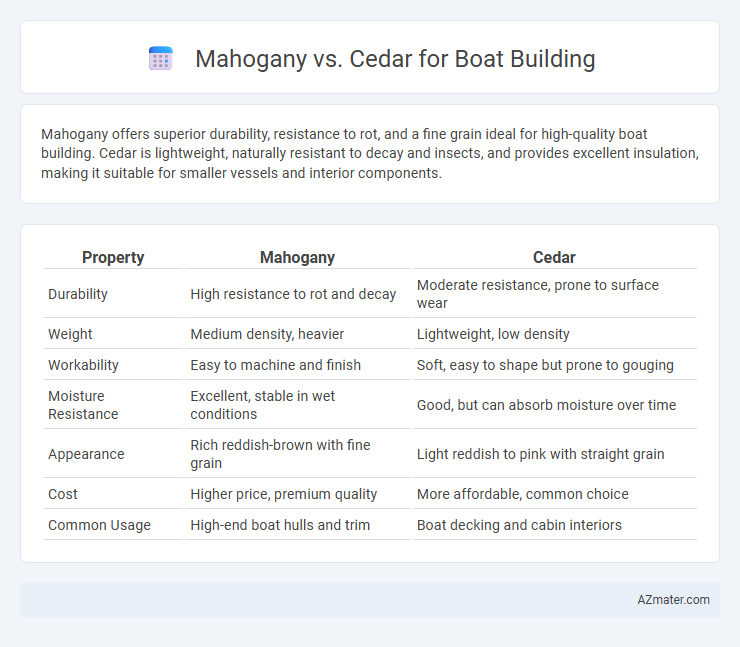Mahogany offers superior durability, resistance to rot, and a fine grain ideal for high-quality boat building. Cedar is lightweight, naturally resistant to decay and insects, and provides excellent insulation, making it suitable for smaller vessels and interior components.
Table of Comparison
| Property | Mahogany | Cedar |
|---|---|---|
| Durability | High resistance to rot and decay | Moderate resistance, prone to surface wear |
| Weight | Medium density, heavier | Lightweight, low density |
| Workability | Easy to machine and finish | Soft, easy to shape but prone to gouging |
| Moisture Resistance | Excellent, stable in wet conditions | Good, but can absorb moisture over time |
| Appearance | Rich reddish-brown with fine grain | Light reddish to pink with straight grain |
| Cost | Higher price, premium quality | More affordable, common choice |
| Common Usage | High-end boat hulls and trim | Boat decking and cabin interiors |
Introduction to Mahogany and Cedar in Boat Building
Mahogany and cedar are prized hardwoods in boat building for their durability and resistance to moisture. Mahogany offers a tight grain and excellent stability, making it ideal for structural components and finishing work. Cedar is valued for its lightweight properties and natural oils that protect against rot and insect damage, often used in hull planking and trim.
Physical Properties: Mahogany vs Cedar
Mahogany features a dense, hard texture with high durability and resistance to rot, making it ideal for structural components in boat building. Cedar is lighter and softer, offering excellent natural resistance to moisture and decay but less strength compared to mahogany. The dimensional stability of mahogany ensures minimal warping, while cedar provides better insulation and a lighter overall boat weight.
Weight and Buoyancy Comparison
Mahogany offers a denser wood profile with a specific gravity typically ranging from 0.55 to 0.85, making it heavier and providing greater structural strength but slightly reducing buoyancy compared to cedar. Cedar, with its lower density and specific gravity between 0.30 and 0.40, is significantly lighter, enhancing buoyancy and making it ideal for lightweight boat constructions where ease of handling and improved floatation are critical. The choice between mahogany and cedar depends on balancing the need for weight-based durability versus enhanced buoyant performance in marine environments.
Durability and Lifespan
Mahogany offers exceptional durability and resistance to rot and marine borers, making it a preferred choice for boat building with a lifespan often exceeding 40 years under proper maintenance. Cedar is lightweight and naturally resistant to decay and insects but is generally softer, which can reduce its durability in harsh marine environments, resulting in a shorter lifespan of around 20 to 30 years. The denser grain and natural oils in mahogany contribute to greater longevity and structural integrity compared to cedar.
Resistance to Rot and Marine Pests
Mahogany exhibits exceptional resistance to rot and marine pests due to its dense, oily grain structure, making it a preferred choice in boat building for durability in marine environments. Cedar offers moderate resistance to decay and pests, attributed to its natural oils, but it is generally less durable than mahogany in prolonged water exposure. Both woods provide valuable qualities, but mahogany stands out for superior longevity and protection against rot and marine organisms.
Workability and Ease of Shaping
Mahogany offers superior workability and ease of shaping due to its fine, straight grain and uniform texture, making it ideal for intricate boat-building details. Cedar is lighter and softer, allowing easier cutting and sanding but can be more prone to dents and requires careful handling for precise shaping. Builders often prefer mahogany for its smooth finish and durability, while cedar is chosen for lightweight projects prioritizing ease of manipulation.
Maintenance Requirements
Mahogany requires regular maintenance involving sanding and varnishing to preserve its rich appearance and resist moisture damage, making it ideal for durability in marine environments. Cedar, while naturally resistant to rot and insect damage, demands less frequent sealing but may require occasional reapplication of protective oils to maintain its structural integrity. Both woods benefit from routine inspections and timely repairs to prevent water intrusion and extend the lifespan of boat hulls.
Cost and Availability
Mahogany offers durability and an attractive finish but comes at a higher cost due to limited availability and import restrictions, making it a premium choice for boat builders. Cedar is more abundant and affordable, often sourced locally, which reduces expenses while still providing good rot resistance and lightweight characteristics ideal for boat construction. Choosing between mahogany and cedar depends on budget constraints and the prioritization of material longevity versus immediate cost savings.
Aesthetic Appeal: Grain and Color Differences
Mahogany boasts a rich, reddish-brown hue that deepens with age, featuring a fine, straight grain that adds elegance and warmth to boat interiors and exteriors. Cedar presents a lighter, more variable palette ranging from pale pinks to deep reds, with a distinctive aromatic scent and a pronounced, often knotty grain pattern offering a rustic, natural aesthetic. The choice between mahogany and cedar can significantly influence a boat's visual appeal, aligning with either a classic, polished look or a more casual, textured style.
Which Wood is Best for Your Boat Project?
Mahogany offers exceptional durability and resistance to rot, making it a top choice for boat building, especially for high-end vessels requiring a smooth, attractive finish. Cedar is known for its lightweight properties and natural resistance to decay and insects, ideal for smaller boats or projects where ease of handling and a vibrant natural look are priorities. For longevity and structural strength, mahogany surpasses cedar, while cedar provides better insulation and is more cost-effective for budget-conscious boat builders.

Infographic: Mahogany vs Cedar for Boat Building
 azmater.com
azmater.com